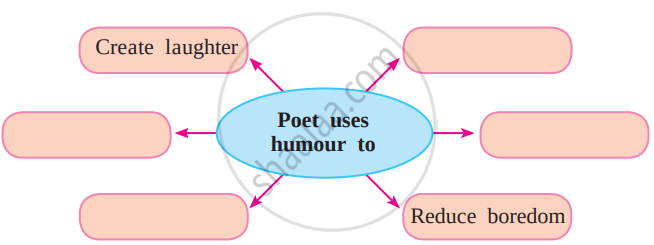Advertisements
Advertisements
Question
Write in your notebook, the summary of this poem in about 15 to 20 lines in your own words. You can suggest another humourous title.
Solution
The Goof-up
The poet, Henry Sambrooke Leigh has placed ‘twins’ at the core of this poem. The twins are identical in every aspect – height, build, features, and physique. They look so alike, that they are constantly mistaken for each other and this becomes the central point of the poem. To begin with, even relatives and friends seem puzzled, constantly mixing up the two brothers. Just before their christening, as they were being bathed by the nurse, they were switched mistakenly and got each other’s names. At school too, the brighter of the two, the poet, gets beaten by the teachers, for John’s mistakes. The poet asks everyone to suggest ways to prove his identity. Things get quite serious when the poet’s bride-to-be marries John. The ultimate mix up happens when John is buried accidentally instead of the poet, who has died.
APPEARS IN
RELATED QUESTIONS
Two babies born at the same time are called twins. Guess and share who are:
- triplets
- quadraplets
- quintiplets
Imagine you had an identical twin (brother or sister). Imagine and share with your classmates what pranks you two would play on your friends, elders in the family, and even in school.
Rewrite putting the mistakes in the speaker’s life, in their proper order.
- The speaker got beaten-up, often, at school.
- The speaker’s bride became his brother’s wife.
- The speaker desparately asked for guidance.
- No one in the family could distinguish between the twin- babies.
- At the naming ceremony, wrong names were given to the two twin brothers.
- Even in death, the twins were not spared during burial.
Pick out four situations in the lives of the twins, which are too absurd and senseless to believe.
- ____________
- ____________
- ____________
- ____________
Complete the web diagram.

Write any two lines from the poem, that you find most humorous.
- __________________
- __________________
Pick out from the poem sets of words that generally go together.
Example: kith and kin
- ____________
- ____________
- ____________
- ____________
Write an Appreciation of the poem with reference to all the points mentioned below.
- Title
- Poet
- Rhyme Scheme
- Favorite Lines
- Theme/Central Idea
- Figures of Speech
- Special features
- Why I like/dislike the poem
Read the given poem and write an appreciation of the poem using the points given below of the poem.
|
The Twins In form and feature, face and limb, One day, to make the matter worse, This fatal likeness even dogged Our close resemblance turned the tide - Henry Sambrooke Leigh |
- Title – (½)
- Name of the poet – (½)
- Rhyme Scheme – (1)
- Figures of Speech – (1)
- Theme / Central idea (in about 2 to 3 lines) – (2)
